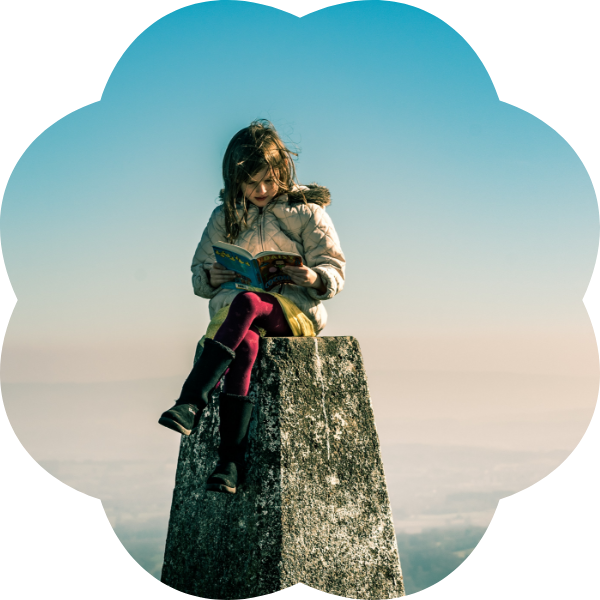Storytelling for a greener tomorrow
Can children's books inspire behavioural change? | By Fiona Barker

Hi, I’m Fiona Barker. I'm a children's book author who studies behaviour change especially as it relates to healthcare and the environmental. I also work as a healthcare scientist helping people who struggle with dizziness.
Picture books can have a profound impact on people. They help to seed lifelong memories. Readers of all ages have emotional connections to their favourites: witness me in a second-hand bookshop reunited with Ladybird Book’s Smoke and Fluff or greeting some other literary treasure from my childhood like an old friend.
But is there something more to it than just emotion and fond memories? Do books have the power to change behaviour?
Children are the future
Picture books have been shown to have an influence on creative behaviour, social behaviour and food choices. But what about green behaviour? Whitney Houston sang that ‘children are the future’. They’ll be the business leaders and consumers of tomorrow. Teaching them well and letting them lead the way is definitely a good idea.
As a behavioural scientist and the author of my own forthcoming green picture book, I want to find out whether children who read green books actually grow up to be ecologically conscious adults.
Green books for children have been around for a long time; just think of The Lorax by Dr Suess. Recently, there has been a slew of new books out there with green themes. My fellow authors tell me that, like everyone else, they have been inspired by TV shows like Blue Planet II and by the increasing awareness of issues around sustainability and climate change.
Mum, turn off the lights!
There have been some studies that show that picture books can influence ecological knowledge and/or behaviour. I put out a few feelers to see if anecdotal data from my colleagues backed this up. Fiona Lumbers, author and illustrator of Clem and Crab and illustrator of The Secret Sky Garden, told me that tangible outcomes from her work include getting children involved in beach cleans, regular litter collections and gardens created from derelict areas. Jill Calder, illustrator of The Sea by Miranda Krestovnikoff, and Neal Layton, author and illustrator of A Planet Full of Plastic, have both seen kids taking responsibility for recycling, re-using and reducing their need for plastics.
I also asked the members of the 17k strong Sustainable(ish) Facebook group whether they had seen changes in sustainable behaviour in their own families or more widely as the result of being exposed to green stories in books. I’ve picked out a few concrete examples. Karen said "My son's school did a book about polar bears and at the end it talks about climate change. My son now tells me off if I forget to turn a light off." Ellie Jackson, an author of several green books herself including Duffy’s Lucky Escape told me "I had gone in to do a book reading and assembly with them a couple of years ago about ocean plastics and single use plastics. This has then led to them becoming very focused on what they can all do to help."
So how do they do it? What are the magic ingredients in picture books that can inspire behaviour change?
Tangible tips and David Attenborough
I think this is a strong area for further research; classifying content into behaviour change techniques and linking these back to behavioural theory relating to specific green practices. My author interviewees had certainly considered this. Catherine Emmett, author of King of the Swamp, and Emily House, author of Earth Takes A Break, felt it helped to have the message being conveyed by a relatable, likeable character; the cuddly McDarkly as the eponymous king and a personified Earth. Karen Swann, author of The Tale of the Whale, placed objects children would recognise in her story such as juice bottles/other common plastic household items and included a direct call for action at the end. Fiona Lumbers models the behaviours she wants children to emulate in her text and illustrations. She shows how Clem organises a beach clean and how Funni creates her garden. Leisa Stewart-Sharpe, author of the non-fiction Blue Planet II, said giving tangible tips and sharing examples of the adults taking positive steps makes it easier for children to learn. It also helps to have a forward by Sir David Attenborough! Author visits and events provide opportunities for everyone to try and put green behaviours such as recycling into practice.
Changes in behaviour are needed in order to make our life on Earth sustainable for all. Picture books have the potential to convey green messages to young children and their parents in an accessible, relatable way. Anecdotal evidence suggests this can result in measurable behavioural outcomes. It would be fascinating to study this in a more systematic way. PhD anyone?
Article written by Fiona Barker. Her new book Setsuko and the Song of the Sea is available for pre-order now. It supports the work of The Marine Conservation Society.
Photo by Carl Jorgensen on Unsplash
Please consider supporting our journalism: https://www.paypal.com/donate?hosted_button_id=FFQ2VNZ6Z6BYG

